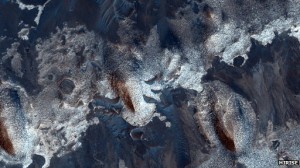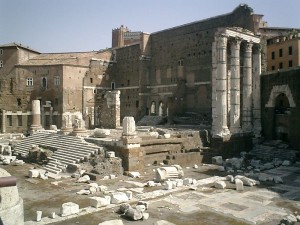Mars: From Roman God of War to First Science Feed in Latin. Posted by Brittany Britanniae on Sep 11, 2013 in Latin Language
Ancient Mars
Mars [Latin: Mars or Marvors] was the Roman god of war (the Greek god of war was Ares). Mars’ placement in Roman mythology is near identical to that of Greek Mythology. Some major myths that include Mars can be read on here. However, Romans had a different appreciation for Mars than the Greek had for Ares. The foundation of Rome was credited to a son of Mars: Romulus.
From Mars, the month of March was named; it was in March that many festivals to Mars were held. Mars was also very important to the religion of everyday Romans; as can be seen by the evidence of the temples to Mars. The most famous temple to Mars was built by Emperor Augustus: Mars Ultor or Mars the Avenger.
Modern Mars
In tradition of all the planets, the fourth planet from the sun was named after a Roman God. The planet Mars was named after the god of war due to its red color (reminiscent of blood). The red color of Mars is due to iron rich minerals on its surface. The planet Mars has two moon of known as Phobos and Deimos. These two names, respectively, are from the Ancient Greek for Fear and Terror. [ To those Disney Hercules fans, it is these two names which Hades’ servants Pain & Panic are derived from.] The following video features Mars’ two small moons as captured by Curiosity Mars Rover :
Modern day audiences have a fascination with Mars; it is clear through our movies, music, books, and science fiction. Books on Mars can be seen here; while movies on the red planets are listed here. In the last few years we have seen a resurgence in the exploration and discovery of Mars from the Curiosity Rover to the launch of the HiRise. HiRise stands for High Resolution Imaging Science Experiment which “Explores Mars, One giant image at a time.” The great thing about this experiment is that the images are available to the public through HiRise’s website, twitter, and tumblr. Here is their main website.

Life on Mars: Materia cana rerum stratarum in Melani Chasmate -or- Light-toned stratified materials in Melas Chasma (the image has been colored).
Bringing Mars and Latin Back Together
The images’ captions are being translated in several languages: French, German, Spanish, Italian, Portuguese, Dutch, Icelandic, Italian, Greek, Russian, and Arabic. You can learn about the Translation Program here. However, one language that HiRise’s page does not show is Latin, BUT it does have a live Latin twitter feed and tumblr feed. This is actually the first science feed done completely in Latin. BBC News even wrote an article on the translator’s progress in this Latin Project. The Latin project is known as “Making Mars Speak Latin” was made possible through the Iris Project.
You may view “Beautiful Mars Latin” Tumblr Images in Latin Here.
An interview with the lead of the translating team, Dr. Lorna Robinson of the Iris Project, quoted the following:
“There has been debate over whether to keep the Latin more simple or make it as close to classical Latin as possible.
We reached a compromise – wanted to keep it clear and accessible to outsiders without being wrong.”
The volunteer translating program has 21 members who translate weekly assignments in Latin through discussing the scientific terms and deducing what terms would best suit the translation and the audience translating it. Dr. Lorna Robinson also commented on how surprised she was to see that many of Mars’ terrain features already had Latin names: “One of the fascinating things for me has been discovering how many parts of Mars have been named in Latin.” As can be seen in this image: “Valles Marineris” is very similar in the English and Latin.
The efforts made by HiRise to inform and update the public in as many languages possible is amazing. The HiRise camera used sends over 12 images back to Earth each day and will be in use until 2023. As of August, there were about 30,000 images of beautiful terrain. It is this beautiful terrain of glaciers, dunes, craters, valleys, and more that are giving the Latin Translators some difficulties- since in Latin courses scientific terms are not usually taught. However, it is a wonder example of how Latin is not a dead language, but continues to find ways to grow and adapt in modern society.

Build vocabulary, practice pronunciation, and more with Transparent Language Online. Available anytime, anywhere, on any device.
About the Author: Brittany Britanniae
Hello There! Please feel free to ask me anything about Latin Grammar, Syntax, or the Ancient World.







